Roulette, with its spinning wheel and bouncing ball, has been a source of fascination and speculation for gamblers and mathematicians alike. While roulette is often considered a bigbet game of chance, the science of probability plays a crucial role in understanding the dynamics of the game. Here’s a glimpse into the intricate relationship between roulette and probability.
1. The Basics of Roulette Probability: Roulette wheels come in two main variations: American (with 38 pockets) and European (with 37 pockets). Each pocket is numbered, and the colors alternate between red and black. The green pocket contains the single zero (European) or both zero and double zero (American). The probability of the ball landing on any specific number or color is determined by the wheel’s configuration.
2. Probability and Payouts: Understanding the relationship between probability and payouts is essential for strategic play. In a simple bet on red or black, there are 18 red pockets and 18 black pockets (excluding the green ones). This leads to an almost 50-50 chance of winning. However, the presence of the green pocket (zero or double zero) slightly tilts the odds in favor of the house.
3. The Law of Large Numbers: The Law of Large Numbers suggests that as the number of trials (spins in this case) increases, the observed results (landings on specific numbers or colors) will converge to the expected probability. In the short term, individual spins may deviate significantly from expected outcomes, but over a large number of spins, the actual results should align with probability predictions.
4. Strategies and Probability: Various betting strategies are employed in roulette, some based on the idea of exploiting probability patterns. However, it’s crucial to recognize that each spin is independent, and previous outcomes do not influence future spins. Betting systems, like the Martingale, may alter the risk profile of individual bets but don’t change the underlying probability.
5. Expected Value: The expected value (EV) is a statistical concept that represents the average outcome of a random event over the long term. In roulette, the EV of a bet is influenced by the probability of winning and the corresponding payout. Positive EV indicates a favorable bet, while negative EV suggests an unfavorable one.
6. Biases and Wheel Imperfections: While modern roulette wheels are designed to be precise, imperfections can occur due to wear and tear or manufacturing flaws. Biases in the wheel can lead to certain numbers or sectors being favored. However, casinos actively monitor and maintain their equipment to minimize such advantages.
7. Randomness and Chaos Theory: Despite the apparent randomness of the ball’s movement, some argue that the chaos is deterministic and influenced by initial conditions. The study of chaos theory suggests that small changes in the starting conditions can lead to significantly different outcomes, contributing to the unpredictable nature of roulette.
In conclusion, while probability forms the backbone of roulette, the game remains a thrilling and unpredictable venture. Understanding the science of probability can inform strategic decisions, but it’s essential to approach roulette with the awareness that each spin is an independent event. The allure of the game lies in the dance of chance, where the spinning wheel holds the secrets of where fortune might land.




